|
 Secure Site
Secure Site
|
 |
Archive for the 'Yoga Timer' Category
 slow down to detox By Hillari Dowdle
Reducing stress and mental overactivity is perhaps the most important element of a successful detox plan, Blossom says. Habitual rushing, multitasking, and dealing with information overloads are the trifecta of American toxicity. And like an overtaxed liver, an overtaxed mind and nervous system can lead to a host of health issues, including adrenal fatigue, insomnia, irregular menstrual cycles, indigestion, and unwelcome weight gain.
The first step in reducing the toxicity created by an overloaded life? Slowing down. During the next seven days, adjust your schedule so you have time to prepare and eat your meals in a relaxed manner, practice daily yoga, and take regular meditation breaks. By saying “no” to the outside influences that pull your attention and energy in so many directions—and replacing them with healthier choices—you’ll begin to tune in to your body’s natural rhythms and detox more effectively.
 Zen Timepiece, a timer with bowl gong for slowing down adapted from Yoga Journal.com
Now & Zen, Inc.
1638 Pearl St.
Boulder, CO 80302
(800) 779-6383
Posted in yoga, Yoga Timer, Yoga Timers by Now & Zen
 cherry blossoms Odorless, tasteless flower essences are the basis of a popular stress-relieving treatment that dates back to the 1930s.
By Steffie Nelson
Bach’s Rescue Remedy, a popular stress-relieving treatment, has been helping people chill out for decades. But if you asked regular users what’s in it, most would get it wrong. It’s a blend of five flower essences, but like all remedies used in flower essence therapy, it contains no physical part of the flower.
Flower essences are odorless, tasteless infusions of flower blossoms. Originally developed in the 1930s by British physician Edward Bach, they’re designed to treat emotional imbalances caused by temporary troubles such as fear, anxiety, or panic, or by long-term problems with your love life or career. Bach crafted 38 remedies that bear his name and are still used; hundreds of other versions have been created by independent flower-essence makers all over the world. (They are especially popular in Cuba, where they’re covered by the national health care system.)
Practitioners of the therapy acknowledge that by the standards of Western medicine, it’s hard to see how something so diluted could have healing effects. But Richard Katz, founder of the Flower Essence Society, based in Nevada City, California, says a different paradigm applies: “Flower essence therapy is based on the idea that a human being is more than biochemistry. We have a soul and an energy field.” Katz says the essences work on a subtle level. “The vibrational quality of the flowers elicits different healing responses in the body,” he says, “just as the vibrations from different types of music will elicit different responses.”
Most essences work best in monthlong treatments, taken up to four times a day. Place them under your tongue or dilute them in a glass of water; dab them on the pulse points on your wrists or neck; or swirl them into your bath. Choosing the right essence is key, so find a practitioner who will take a detailed inventory of your emotional state, work life, and relationships. The Flower Essence Society (www.flowersociety.org) can provide referrals.
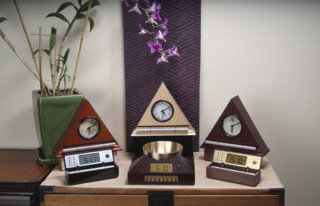 Now & Zen's Family of Products, Boulder, Colorado Now & Zen, Inc.
1638 Pearl St.
Boulder, CO 80302
(800) 779-6383
adapted from Yoga Journal.com
Posted in yoga, Yoga Timer, Yoga Timers by Now & Zen
 Kid Yoga Lotus Pose Kick up your heels a little on your way to wisdom, freedom, and joy.
By Jenny Sauer-Klein
The great philosopher Plato said, “You can discover more about a person in an hour of play than in a year of conversation.” Playing is a powerful way to gain insight into yourself, too. Play brings you into contact with your natural state—anando hum(literally, “I am bliss”). It’s a state of harmonious connection with yourself, with your playmates, and with the greater whole. Its spirit is contagious and multiplies itself without effort, raising the vibration of everyone it touches.
Much like the state of deep meditation, true play is a mode of becoming fully present and available to the mystery and wonder of each unfolding moment. In that moment of complete immersion, you release the crystallized assumptions of your past experiences and enter a world of innocence and possibility.
Children can exist in this state for hours because they are not afraid to dream big, to pretend, to bring their fantasies to life; they believe that anything is possible. Falling, laughing, and getting back up to try again come naturally to them. But as we get older, patterns of self-doubt, fear, and mistrust of ourselves or others can interfere with our ability to play with happy abandon,to dare to take risks with an open heart.
Play is my life’s work. When I teach AcroYoga, I’m helping adults to feel like children again,to trust themselves and each other,and to rediscover that belief in infinite possibility. Most adults need a fine balance of structure and freedom in order to feel safe enough to play and take risks. When we fly in AcroYoga (imagine parent and child playing “airplane”), defined roles and rules help ensure everyone’s safety. The magic word is “down,” which means “time out—let’s come back down to earth.” The roles and rules satisfy the intellectual mind, creating space for the flier to experience the pure joy of being held in the air, probably for the first time since childhood. I often see initial fear and doubt turn into elation and empowerment, as people build the trust and confidence they need to spread their wings!
The ancient rishis and seers who gave birth to the practice we call yoga began from this place of freedom and benevolent curiosity, asking questions that would guide the evolution of human consciousness. All of our great systems of knowledge, from medicine to philosophy to the great spiritual traditions, originated from this inherent sense of wonder and openness. Throughout the ages,wisdom has come to those willing to experiment and discover the next leading edge. When you surrender to the spiritual practice of play, you are celebrating the existence of life itself. Are you willing to leave the known behind and ask what is possible now?
Jenny Sauer-Klein is the co-founder of AcroYoga. Find out more at acroyoga.org.
Make A Play Date
Four ideas to bring wonder into your life
Instead of thinking about negative “what ifs,” play the positive “What If” game. Ask yourself, “What if I get my dream job?” “What if I open deeply to love?” Let your dreams become reality by asking, “How could this get any better?” And live the answer!
Try a different style of yoga or a new physical practice, like dance or the martial arts, and become a beginner again. Forgive yourself if you fumble and enjoy the process of learning. Spend time with a child or an animal. Watch them play and discover the world again through their eyes.
Give yourself permission to make a new mistake. Do Tree Pose with your eyes closed and see how long you last. Laugh if you fall down.
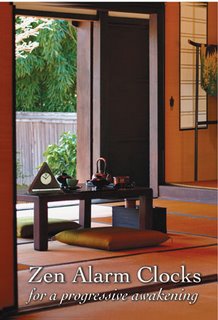 Zen Clocks and timers for yoga and meditation adapted from Yoga Journal.com August 2011
Now & Zen, Inc.
1638 Pearl St.
Boulder, CO 80302
(800) 779-6383
Posted in yoga, Yoga Timer, Yoga Timers by Now & Zen
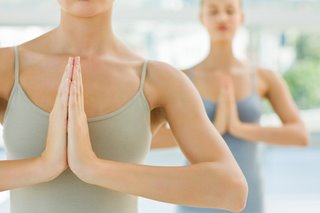 yoga fix Tension can be a pain in the neck. Master these gentle moves to create lasting ease.
By Barbara Benagh
By the time Tatiana Makoukhina came to my workshop last spring on easing tension in the neck, shoulders, and upper back, she’d been suffering from chronic pain for more than a decade. In the early ’90s, as a single mom newly arrived from Russia, Tatiana worried constantly about whether she could make a new life in America with her daughter. She put in long hours as a hotel cleaner—the only job she could find—and felt she could never relax, never stop working and planning. Her back and neck were constantly rigid with tension, she suffered severe migraines, and then she herniated a disk in her lower back lifting a heavy mattress.
Despite her persistent discomfort, Tatiana worked hard to manage her pain and improve her health. Athletic in her childhood—she had loved gymnastics, volleyball, and dancing—she began running and exercising again. Surgery for her disk injury helped with her lower back pain, and her migraines eased once she began practicing yoga regularly in 2002. Still, nothing seemed to banish the tightness, aches, and occasional stabbing pain in her shoulders and neck.
Tatiana certainly isn’t unique: We all live in a world filled with anxiety. We race through hectic days and fall into bed exhausted; we fret over our bills, our kids, our jobs and the state of the planet, too. It doesn’t help that many of us have lives skewed toward the sedentary, with too many hours spent hunkered down behind a computer or steering wheel. Our stress often winds up stored in clenched necks, shoulders, and backs-which eventually weakens our muscles, strains our joints, and limits our range of motion. The tension hangs heavy on our necks and shoulders, as unwelcome as a winter coat on a summer day.
It doesn’t have to be this way, of course. The shoulder girdle is designed so your arms, neck, and shoulders can move freely and easily. Even if you have a history of injuries or have suffered from chronic tension for years, the approach I’ve developed can help you learn to soften your neck and shoulder muscles and restore ease and freedom.
When I ran into Tatiana a few weeks after the workshop, she was thrilled with her progress. Not only had the workshop taken away her pain but, even better, she’d been able to stay pain-free by including 5 to 10 minutes of my exercises in her daily hour of yoga. Her back, shoulders, and neck were feeling more relaxed than she’d ever imagined possible.
Learn to Let Go
Passive relaxation exercises are the core of my program. Just about anyone can benefit from them, even those who’ve never done a single asana. These poses give you a taste of ease and comfort, a touchstone experience you can refer to again and again as you progress into more active exercises and challenging yoga poses.
Relaxing deeply is a sanctuary, yet few of us allow ourselves to enter it. It feels so good that you’d think it would come easily, but many of us are so accustomed to tension that we have to relearn the natural process of letting go.
The first step is simply lying down on your back on a firm, comfortable surface and letting yourself rest. Almost certainly, you’ll feel your muscles naturally releasing tension because they no longer have to work to hold you upright. You may notice you spontaneously let out a sigh of relief.
To relax more deeply, though, you have to consciously build on these natural responses. The secret to doing this is to focus on the movement of the breath in your body, using it to uncover and melt away tension.
Begin by tuning in to your breath. Pick up its rhythm, letting your muscles relax into and move with its gentle rise and fall. Throughout your practice, let this rhythm hold your attention. Feel how your breath creates an effortless expansion and contraction. Also notice any places in your body that seem tense or immobile or unresponsive to the ebb and flow of your breathing. To help them release, imagine saturating these tight, dull areas with the easy rhythm of your breath; if that doesn’t work, imagine your breath originating deep within your tense places.
Bringing your attention to your contracted spots will probably help them release. But if you’re like most people, you’ll also discover tension that’s stubbornly resistant to letting go. When that happens, remember to be patient and curious.
Chronically clenched muscles can feel tender, sore, rock hard, numb—or some combination of these sensations. Let your awareness drop deeper and deeper into each tight area, getting to know its specific character. With your breath, ask your muscles to slowly shift from tension to release, from density to expansion, from hard to soft.
Once you’ve experimented with this undoing process, apply it in some simple reclining positions like the Neck Blanket Stretch and the Arm-under-Back Stretch. These positions use body weight, position, and basic props to create gentle traction on classic neck and shoulder hot spots.
As you explore these passive exercises, don’t expect your tensions to melt away instantly. To undo your chronic patterns of holding, you have to learn to focus completely on letting go, and that takes time. Your undoing skills will mature with practice. The more often and more deeply you relax, the deeper your breath will penetrate, and the more subtle your awareness will become.
By starting the undoing process, you’ve begun a conversation with the residue your past has left behind in your body. Not only can the process lead you to much greater comfort, but it can also be profoundly contemplative and rich with insight. As you relax, you may discover emotions and memories that seem to have been locked within your tension. Years after my accident, I uncovered a surprising amount of anger at my sister for pushing me to go on that fateful date. The undoing process has led me to unexpected stores of positive feelings, too; when I began to practice again after a nearly fatal asthma attack, I found myself flooded with joy and gratitude.
As you continue to release chronic muscular holding, you’ll sense that contraction creates subtle vibrations of mental unease, and as these dissipate, you’ll discover that easing tension from your neck and shoulders calms your mind, too.
 Yoga Timer with Tibetan Singing Bowl Use our unique “Zen Clock” which functions as a Yoga Timer. It features a long-resonating acoustic chime that brings your meditation or yoga session to a gradual close, preserving the environment of stillness while also acting as an effective time signal. Our Yoga Timer & Clock can be programmed to chime at the end of the meditation or yoga session or periodically throughout the session as a kind of sonic yantra. The beauty and functionality of the Zen Clock/Timer makes it a meditation tool that can actually help you “make time” for meditation in your life. Bring yourself back to balance.
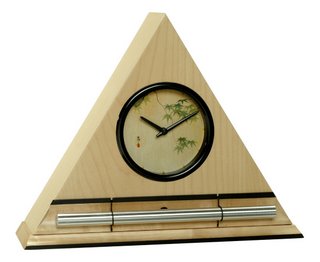 yoga accessories Now & Zen’s Yoga Timer Shop
1638 Pearl St.
Boulder, CO 80302
(800) 779-6383
Adapted from Yoga Journal.com by Barbara Benagh has taught yoga for 30 years. She lives in Boston and cofounded the Cambridge studio Yoga 301. Her website is www.yogastudio.org.
Posted in yoga, Yoga Timer, Yoga Timers by Now & Zen
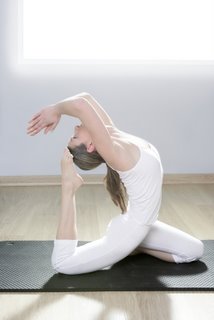 yoga body mind Release negative emotions and
improve your alignment by opening
the muscles around your hips.
By Diane Anderson, sequence by Stephanie Snyder
There are so many reasons to do hip-opening poses: Supple hips can ease back pain, give you a more agile gait, and even improve circulation in your legs. But there’s a more subtle benefit to hip openers, too: We hold stress and negative emotions—such as fear, guilt, and sadness—in our pelvis, says San Francisco vinyasa teacher Stephanie Snyder. For this reason alone, Snyder believes it’s particularly important to do poses that move prana (life force) through that area. “You know your junk drawer at home?” she asks. “The pelvis is like the body’s junk drawer. Whenever you don’t know what to do with a feeling or experience, you put it there.”
Snyder designed the following sequence to move your ball-and-socket hip joint through its full range of motion. When you do it regularly, you may see improvement in the rest of your practice, since the pelvis is the foundation of alignment in many poses. Here are some things to remember as you
do the sequence. Take your time with opening your hips, because hip ligaments are strong. “Don’t push yourself,” Snyder advises. “Be receptive to the breath moving into the pose.” If you have a knee injury, modify the seated poses (5 and 6) by straightening your bottom leg, and practice poses 7 and 9 on your back. At the same time, don’t avoid difficulty. People often dread hip openers because they are such a challenge. “Don’t look away from tight places,” Snyder says. “Be present without judgment. You can really make this a delicious practice.”
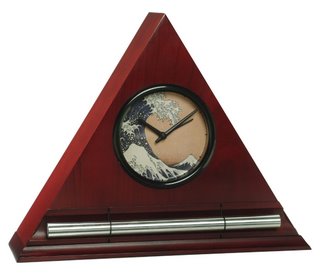 Yoga tools and timers Now & Zen, Inc.
1638 Pearl St.
Boulder, CO 80302
(800) 779-6383
adapted from Yoga Journal.com
Posted in yoga, Yoga Timer, Yoga Timers by Now & Zen
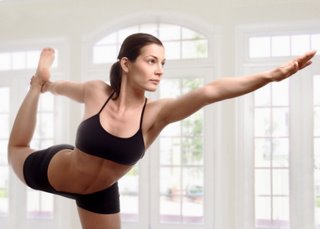 Winter Yoga For winter sports fans, yoga offers refined technique, better balance, and the freedom to fly.
When Hannah Dewey skis, she likes to go fast. “I tend to powerhouse it,” she says. “I muscle my way through.” As a longtime skier and a professional wildfire fighter, Hannah is strong enough to ski fast, even uphill. But after 22 years of skiing, she’s learned something surprising, a lesson that comes from her yoga practice: To get the most power, she has to slow down and focus her mind on the present moment. “If I go calmly step by step, concentrating on my form, I can actually go faster,” she says.
I met Hannah, along with more than 40 other skiers, at the eighth annual Women’s Ski and Yoga Retreat in the Methow Valley of northern Washington. I joined a group of athletes who do yoga for many reasons: to enhance their performance on skis, to ward off injury, and to experience the singular bliss that comes from a focused effort and a clear mind. “Yoga and skiing go together for me,” says Mary Ellen Stone, another retreat regular. “They’re both ways of putting away all the clutter in our lives and focusing physically, emotionally, and technically on something that’s not easy to do. But when it all comes together, it’s one of the best feelings in the world.”
I’d come to have my own experience of the synergy of yoga and skiing, but because I hadn’t skied since
I was a kid, getting faster was not my primary goal. Still, the lessons I’d internalized in my years of yoga practice turned out to serve me well on the trails.
Let It Snow
The secluded Methow Valley is a Nordic skier’s paradise. A popular place for Olympic skiers to train,
the valley has 120 miles of cross-country trails—one of the longest systems of groomed trails anywhere
in North America—as well as access to many more miles of challenging backcountry ski routes in the 4 million acres of the surrounding Okanogan-Wenatchee National Forest.
The women meet at Sun Mountain Lodge, the mountaintop resort hosting the retreat, which
is organized by the nearby Winthrop Fitness center. Many of my fellow retreat participants have skied competitively. Some are experts at downhill skiing but have come to master cross-country. A few are snow-sport newbies like me.
At 7 o’clock the next morning, I warm up my resistant quadriceps in Melanie Whittaker’s yoga class. Melanie is a cross-country skier and the yoga director for Winthrop Fitness, and has been practicing yoga for more than 30 years. She teaches an Iyengar-inspired style and counts elite skiers and other athletes among her students. She explains that we’re preparing ourselves to move forward with agility and speed while balancing on a slippery and constantly changing surface of snow and ice. For the next 90 minutes, she leads us through a series of strong
poses like Ardha Chandrasana (Half Moon Pose) and Virabhadrasana (Warrior Pose) I, II, and III, which call for strength, balance, and confidence—the same qualities we’ll need
to draw on once we strap on our skis.
Moving with any sort of grace on a slippery surface is inherently challenging, she tells us,
as we do Utkatasana (Chair Pose), and to keep our balance we’ll need a strong, compact form and a low center of gravity. She also reminds
us that to be successful at skiing, as with yoga, we have to learn to trust our bodies. When we do Handstand, she reminds us that it is trust that allows us to bring our hips over our heads, and our legs into the air. I’ll have occasion to remember her words later in the day.
Free Fall
After class I make my way, skis in hand, to a flat, groomed field for my beginner’s lesson.
A misty fog floats across the hills, just above the treetops, and occasional watery sunshine glints from behind the clouds.
The two most common kinds of cross country skis—classic and skate—have corresponding, but different, techniques. To move forward on classic skis, you keep your feet
parallel and execute a series of gliding lunges. With each step, you shift your center of gravity forward, bringing your body weight fully over the ball of the front foot, almost past the point where you feel you’re going to fall, while pushing the ground away with your back leg. To
balance and stay stable, says my instructor, you tuck into an Utkatasana-like form, bending your front knee and ankle, dropping your sitting bones, and firming your core.
When I ask some of the more experienced skiers, like Hannah, how their yoga practice supports their skiing, they emphasize core strength and balance. “In skiing, my form comes from my core,” says Hannah. “I concentrate on keeping my core really tight, and my legs just follow.” As the ski class gets under way, I see what she means. If I bend my ankles and knees and tip my weight forward, I glide. If I straighten up out of that slight tuck, I
wobble and, more often than not, fall.
“Bend your knees and ankles,” shouts my instructor. “Weight forward!” I bend my knees. I bend my ankles. I drop my sitting bones, finding the skier’s Utkatasana. I connect to the strength in my ankles, calves, and thighs and, with a slight adjustment, release my body weight forward. And there it is. I am gliding with a remarkable feeling of ease, making wide turns down the slope. I no longer feel that the skis are unruly clown shoes, tripping me up. They are seamless extensions of my legs, and they do my bidding.
That afternoon, we take off down a trail into the forest. I experience a delicious sense of well-being and freedom as I slide through the quiet forest and enjoy the afternoon sunlight gleaming through pine trees decked with garlands of sage-green moss. I’ll never look at Utkatasana the same way after today. Instead of feeling like a sweaty struggle for balance, it now feels like the pose of victory.
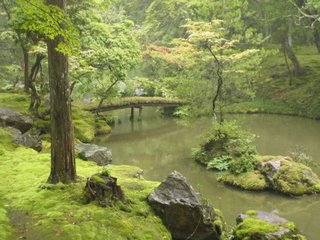 Moss Garden Restore and Tend
That evening, the group meets for an apres-ski stretch, and I find Melanie for a quick consultation. All of that forward crouching has left me with a sore back. She has me try a variation of Sphinx Pose, in which I press my hands into the ground and work my upper arms toward each other to open up my upper back and chest. A supine twist relieves my lower back, and Supta Baddha Konasana (Reclining Bound Angle Pose) helps release the piriformis, a muscle deep in the buttocks that tends to tighten in skiing.
As to my other aches and pains—I’m feeling my shoulders, arms, core, inner thighs, outer thighs, calves, and ankles—she tells me I’m making the rookie mistake of unnecessarily gripping a lot of auxiliary muscles I don’t need to in the process of trying to engage the ones I do. “You’ll get more power and control when you learn to isolate the muscle groups you need,” she says. “You’ll also be a lot less sore and fatigued at the end of the day. Practicing the body awareness you learn in yoga will help you on the slopes.”
Being Balance
In the next morning’s yoga class, Melanie brings our attention to our feet. Being aware of our feet, she tells us, is a critical factor in balance. In Utthita Parsvakonasana (Extended Side Angle Pose), we practice putting even pressure through the entire foot, observing how the slightest shift to one side can unbalance us.
The skiing portion of the second day focuses on skate-style skiing. Skate skis are especially slippery. When you are moving across the snow’s slick surface, the slightest muscular effort creates motion, which presents a new kind of balancing challenge. To gain control of my movement, says my instructor, I have to master the art of “edging,” or delicately shifting weight to the inner edge of my foot to grip into the snow, which will allow me to push off into a glide.
As I slide around like a bumper car, I try to remember to spread my toes and keep my feet relaxed so that I can control how my weight shifts. Meanwhile, I’m fielding more instructions: Bend your knees, push off the back foot, shift weight to the front foot, bring one pole forward. Every time I try to do one thing the instructor tells us, I forget the others, tense up, and lose my balance. Finally she notices my difficulty and gives me yet another instruction: “You—just stop thinking!”
I pry my gaze away from my feet, look straight ahead in the direction I want to go, and thrust myself forward into a glide. I plunge forward, and this time I start to get the momentum, the slight swaying, the powerful back-leg strokes pushing me forward. I grin like a little kid, glancing at the teacher to make sure she sees me before my next slippery fall.
And then it occurs to me: Balance is not something you achieve and hold on to. It’s more ephemeral; it’s a string of temporary successes, held momentarily, lost, and then discovered again. Skiing gives you a fleeting experience of balance with each shift of weight and each glide. But it’s not permanent. When you lose it, you just have to have faith that you’ll come back to it.
Sweet Surrender
I feel I’ve been treated to a glimpse of the synergies of yoga and skiing. Hannah told me that her favorite yoga teacher reminds her to slow down and stay focused when she starts to rush through her Sun Salutations. Of all the benefits that her practice confers on her sport, she says, the most important one has come in the form of a mental shift: “Yoga has helped me slow down and concentrate on myself, and on having a good time out there.”
Mary Ellen echoes this sentiment: “When you’re out there and you see the snow sparkling on the trees and hear the ravens calling, you think, ‘I’m so lucky, so extraordinarily lucky, to be doing this.’ It’s a deep feeling, being there, right in that moment. That feeling is hard to come by.”
After dinner on the last night of the retreat, I make for the hot tub. I set my chin on the cold rock ledge of the tub and count a handful of lights in the houses in the valley below. The rest of my view consists of the snow-blanketed Mount Gardner. The full moon shines through the spreading branches of a pine tree on the slope before me. A rumbling sound disturbs the quiet as the trail grooming machine starts up. To my ears, it’s a sweet sound, promising freshly groomed trails to glide down in the morning.
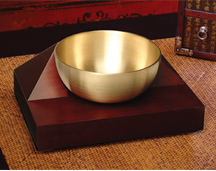 Timers for Yoga and Meditation with Tibetan Singing Bowl Use our unique “Zen Clock” which functions as a Yoga Timer. It features a long-resonating acoustic chime that brings your meditation or yoga session to a gradual close, preserving the environment of stillness while also acting as an effective time signal. Our Yoga Timer & Clock can be programmed to chime at the end of the meditation or yoga session or periodically throughout the session as a kind of sonic yantra. The beauty and functionality of the Zen Clock/Timer makes it a meditation tool that can actually help you “make time” for meditation in your life. Bring yourself back to balance.
 Meditation timers and chime clocks by Now & Zen, Inc. Now & Zen’s Yoga Timer Shop
1638 Pearl St.
Boulder, CO 80302
(800) 779-6383
Adapted from Yoga Journal.com, By Carmel Wroth, sequence by Melanie Whittaker.
Posted in Well-being, yoga, Yoga Timer, Yoga Timers by Now & Zen
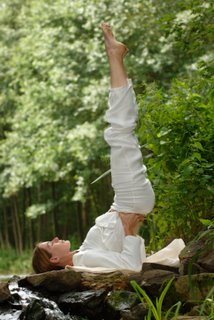 wellness practice of the day Before the hustle-bustle of the holidays throws your routine off-kilter, take some time to reconnect with the earth, viewed in most mind-body traditions as the source of power and stability. “We’re often mentally hovering a few feet above the ground,” says Kate Hanley, author of “The Anywhere, Anytime Chill Guide.” “It’s important to get back in touch with the ground beneath you.” So make a five-minute savasana your new daily habit: Set your Zen Wellness Timer for 5 minutes, lie on your back with your eyes closed, listening to your breath and feeling the earth support you.
adapted from Wholeliving.com, October 2010
Use our unique “Zen Clock” which functions as a Yoga & Meditation Timer. It features a long-resonating acoustic chime that brings your meditation or yoga session to a gradual close, preserving the environment of stillness while also acting as an effective time signal. Our Yoga Timer & Clock can be programmed to chime at the end of the meditation or yoga session or periodically throughout the session as a kind of sonic yantra. The beauty and functionality of the Zen Clock/Timer makes it a meditation tool that can actually help you “make time” for meditation in your life. Bring yourself back to balance.
 Wellness Timer, The Digital Zen Alarm Clock in Solid Walnut
Now & Zen – The Zen Alarm Clock Store
1638 Pearl Street
Boulder, CO 80302
(800) 779-6383
Posted in intention, mindfulness practice, Well-being, Yoga Timer, Yoga Timers by Now & Zen, Zen Timepiece by Now & Zen, Zen Timers
 woman sun salutation yoga surya namaskar pose A kundalini awakening is when energy flows freely upward through the chakras and leads to an expanded state of consciousness. But is it safe?
According to Tantra, kundalini energy rests like a coiled serpent at the base of the spine. When this dormant energy flows freely upward through the seven chakras (energy centers) and leads to an expanded state of consciousness, it’s known as a kundalini awakening.
For some, the experience can be blissful and filled with feelings of love and a sense of the interconnectedness of all things. For others, it can feel more like a bad drug trip, or even a psychotic break, where practitioners go through altered sleep cycles, changes in identity, or depression. This discrepancy has led many Westerners to fear the coiled serpent resting in their spine, ready to strike.
Meditation teacher Sally Kempton had such an awakening in her late 20s, and while she acknowledges that the experience may be scary for those who are without an experienced teacher to guide them, she believes that awakenings are a gift from the universe. “In our tradition, we honor and respect kundalini,” she says. “Her energy is trying to awaken you, expand you, and put you in touch with your own deep energy, which is a fundamentally benign process.”
However, according to Kempton and Stuart Sovatsky, a psychotherapist specializing in spiritual work, kundalini awakenings are rare in Western students because hatha yoga is practiced in a less spontaneous way today. “People are trying to hold the poses in a certain way, as opposed to doing poses that release energy blocks specific to their body,” says Sovatsky.
Still, many teachers caution against attempts to induce an awakening through intense pranayama or other methods. Instead, it should occur spontaneously, when the body is ready. In Tantra: The Path of Ecstasy, yoga scholar Georg Feuerstein explains why: “If you don’t first open the central channels of the nervous system, raising the serpent power along the axial pathway is not only impossible but also very dangerous to attempt, for instead of entering the central channel (sushumna nadi) it is likely to force itself in to the ida or the pingala nadi, on either side of the central channel, causing immense havoc in the body and mind.”
Kundalini reminds us that consciousness is far vaster than most of us have ever imagined, which can seem overwhelming and disorienting. But Sovatsky says that people who have a psychotic break from an awakening usually come from a troubled family background, face high levels of stress, and don’t have enough emotional support. Still, both Sovatsky and Kempton recommend that anyone who is fearful in the midst of such an awakening should seek support from a therapist (such as a transpersonal psychologist) or a teacher who has gone through it herself.
adapted from Yoga Journal by By Nora Isaacs
 bamboo digital zen chime clock and yoga timer Now & Zen
1638 Pearl Street
Boulder, CO 80302
(800) 779-6383
Posted in yoga, Yoga Timer, Yoga Timers by Now & Zen
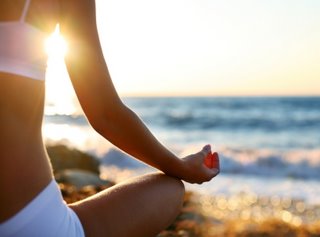 new light on yoga From loincloths to leotards, yoga has come a long way in 5,000 years. But is yoga as we know it really that old?
According to yoga scholars, even the yoga postures—the basic vocabulary of modern hatha yoga—have evolved and proliferated over time. In fact, only a handful of these now-familiar postures are described in the ancient texts. Patanjali’s second-century Yoga Sutra mentions no poses at all, other than the seated meditation posture. (The Sanskrit word “asana” literally means “seat.”) The fourteenth-century Hatha Yoga Pradipika—the ultimate classical hatha yoga manual—lists only 15 asanas (most of them variations of the cross-legged sitting position), for which it gives very sketchy instructions. The seventeenth-century Gheranda Samhita, another such manual, lists only 32. Conspicuously missing are the standing poses—Triangle, Warrior, etc.—and Sun Salutations that form the backbone of most contemporary systems.
Other venerable texts on hatha yoga eschew mention of asanas altogether, focusing instead on the subtle energy systems and chakras that the poses both reflect and influence. The modern emphases on precision of alignment, physical fitness, and therapeutic effects are purely twentieth-century innovations.
Rumors abound about lost, ancient texts that describe asanas in detail—the Ashtanga vinyasa system taught by Pattabhi Jois, for example, is allegedly based on a palm-leaf manuscript called the Yoga Korunta that Jois’s teacher, renowned yoga master T. Krishnamacharya, unearthed in a Calcutta library. But this manuscript has reportedly been eaten by ants; not even a copy of it exists. In fact, there’s no objective evidence that such a document ever existed. In all his voluminous writings on yoga—which contain extensive bibliographies of all the texts that have influenced his work—Krishnamacharya himself never mentions or quotes from it. Many of Krishnamacharya’s other teachings are based on an ancient text called the Yoga Rahasya—but this text too had been lost for centuries, until it was dictated to Krishnamacharya in a trance by the ghost of an ancestor who had been dead nearly a thousand years (a method of textual reclamation that will satisfy devotees, but not scholars).
In general, the textual documentation of hatha yoga is scanty and obscure, and delving into its murky history can be as frustrating as trying to snorkel in the mud-brown Ganges. Given the paucity of historical evidence, yoga students are left to take the antiquity of the asanas on faith, like fundamentalist Christians who believe that the Earth was created in seven days.
Not only is there no clear textual history, but there’s not even a clear teacher-student lineage that indicates systematized oral teachings handed down over generations. In Zen Buddhism, for example, students can chant a lineage of teachers stretching back for centuries, with each Zen master certified by the one preceding. No such unbroken chain of transmission exists in hatha yoga. For generations, hatha yoga was a rather obscure and occult corner of the yoga realm, viewed with disdain by mainstream practitioners, kept alive by a smattering of isolated ascetics in caves and Hindu maths (monasteries). It appears to have existed for centuries in seed form, lying dormant and surfacing again and again. In the twentieth century, it had almost died out in India. According to his biography, Krishnamacharya had to go all the way to Tibet to find a living master.
Given this lack of a clear historical lineage, how do we know what is “traditional” in hatha yoga? Where did our modern proliferation of poses and practices come from? Are they a twentieth-century invention? Or have they been handed down intact, from generation to generation, as part of an oral tradition that never made it into print?
The Mysore Palace
I found myself pondering these questions afresh recently after I came across a dense little book called The Yoga Tradition of the Mysore Palace (South Asia Books, 1996) by a Sanskrit scholar and hatha yoga student named Norman Sjoman. The book presents the first English translation of a yoga manual from the 1800s, which includes instructions for and illustrations of 122 postures—making it by far the most elaborate text on asanas in existence before the twentieth century. Entitled the Sritattvanidhi (pronounced “shree-tot-van-EE-dee”), the exquisitely illustrated manual was written by a prince in the Mysore Palace—a member of the same royal family that, a century later, would become the patron of yoga master Krishnamacharya and his world-famous students, B.K.S. Iyengar and Pattabhi Jois.
Sjoman first unearthed the Sritattvanidhi in the mid-1980s, as he was doing research in the private library of the Maharaja of Mysore. Dating from the early 1800s—the height of Mysore’s fame as a center of Indian arts, spirituality, and culture—the Sritattvanidhi was a compendium of classical information about a wide variety of subjects: deities, music, meditation, games, yoga, and natural history. It was compiled by Mummadi Krishnaraja Wodeyar, a renowned patron of education and the arts. Installed as a puppet Maharaja at age 5 by the British colonialists—and deposed by them for incompetence at the age of 36—Mummadi Krishnaraja Wodeyar devoted the rest of his life to studying and recording the classical wisdom of India.
At the time Sjoman discovered the manuscript, he had spent almost 20 years studying Sanskrit and Indian philosophy with pundits in Pune and Mysore. But his academic interests were balanced by years of study with hatha yoga masters Iyengar and Jois. As a yoga student, Sjoman was most intrigued by the section of the manuscript dealing with hatha yoga.
Sjoman knew that the Mysore Palace had long been a hub of yoga: Two of the most popular styles of yoga today—Iyengar and Ashtanga, whose precision and athleticism have profoundly influenced all contemporary yoga—have their roots there. From around 1930 until the late 1940s, the Maharaja of Mysore sponsored a yoga school in the palace, run by Krishnamacharya—and the young Iyengar and Jois were both among his students. The Maharaja funded Krishnamacharya and his yoga protégés to travel all over India giving yoga demonstrations, thereby encouraging an enormous popular revival of yoga. It was the Maharaja who paid for the now well-known 1930s film of Iyengar and Jois as teenagers demonstrating asanas—the earliest footage of yogis in action.
But as the Sritattvanidhi proves, the Mysore royal family’s enthusiasm for yoga went back at least a century earlier. The Sritattvanidhi includes instructions for 122 yoga poses, illustrated by stylized drawings of an Indian man in a topknot and loincloth. Most of these poses—which include handstands, backbends, foot-behind-the-head poses, Lotus variations, and rope exercises—are familiar to modern practitioners (although most of the Sanskrit names are different from the ones they are known by today). But they are far more elaborate than anything depicted in other pre-twentieth-century texts. The Sritattvanidhi, as Norman Sjoman instantly realized, was a missing link in the fragmented history of hatha yoga.
“This is the first textual evidence we have of a flourishing, well-developed asana system existing before the twentieth century—and in academic systems, textual evidence is what counts,” says Sjoman. “The manuscript points to tremendous yogic activity going on in that time period—and having that much textual documentation indicates a practice tradition at least 50 to 100 years older.”
Potpourri Lineage
Unlike earlier texts such as the Hatha Yoga Pradipika, the Sritattvanidhi doesn’t focus on the meditative or philosophical aspects of yoga; it doesn’t chart the nadis and chakras (the channels and hubs of subtle energy); it doesn’t teach pranayama (breathing exercises) or bandhas (energy locks). It’s the first known yogic text devoted entirely to asana practice—a prototypical “yoga workout.”
Hatha yoga students may find this text of interest simply as a novelty—a relic of a “yoga boom” of two centuries ago. (Future generations may pore with equal fascination over “Buns of Steel” yoga videos.) But buried in Sjoman’s somewhat abstruse commentary are some claims that shed new light on the history of hatha yoga—and, in the process, may call into question some cherished myths.
According to Sjoman, the Sritattvanidhi—or the broader yoga tradition it reflects—appears to be one of the sources for the yoga techniques taught by Krishnamacharya and passed on by Iyengar and Jois. In fact, the manuscript is listed as a resource in the bibliography of Krishnamacharya’s very first book on yoga, which was published—under the patronage of the Maharaja of Mysore—in the early 1930s. The Sritattvanidhi depicts dozens of poses that are depicted in Light on Yoga and practiced as part of the Ashtanga vinyasa series, but that don’t show up in any older texts.
But while the Sritattvanidhi extends the written history of the asanas a hundred years further back than has previously been documented, it does not support the popular myth of a monolithic, unchanging tradition of yoga poses. Rather, Sjoman says that the yoga section of the Sritattvanidhi is itself clearly a compilation, drawing on techniques from a wide range of disparate traditions. In addition to variations on poses from earlier yogic texts, it includes such things as the rope exercises used by Indian wrestlers and the danda push-ups developed at the vyayamasalas, the indigenous Indian gymnasiums. (In the twentieth century, these push-ups begin to show up as Chaturanga Dandasana, part of the Sun Salutation). In the Sritattvanidhi, these physical techniques are for the first time given yogic names and symbolism and incorporated into the body of yogic knowledge. The text reflects a practice tradition that is dynamic, creative, and syncretistic, rather than fixed and static. It does not limit itself to the asana systems described in more ancient texts: Instead, it builds on them.
In turn, says Sjoman, Krishnamacharya drew on the Sritattvanidhi tradition and blended it with a number of other sources, as Sjoman discovered by reading the various books by Krishnamacharya in the Maharaja’s library. Krishnamacharya’s first writings, which cited the Sritattvanidhi as a source, also featured vinyasa (sequences of poses synchronized with the breath) that Krishnamacharya said he had learned from a yoga teacher in Tibet. Over time, these vinyasa were gradually systematized further—Krishnamacharya’s later writings more closely resemble the vinyasa forms taught by Pattabhi Jois. “Therefore it seems logical to assume that the form we find in the series of asanas with Pattabhi Jois was developed during Krishnamacharya’s period of teaching,” writes Sjoman. “It was not an inherited format.” To dedicated Ashtanga practitioners, this claim borders on the heretical.
Along the way, claims Sjoman, Krishnamacharya also seems to have incorporated into the yogic canon specific techniques drawn from British gymnastics. In addition to being a patron of yoga, the Mysore royal family was a great patron of gymnastics. In the early 1900s, they hired a British gymnast to teach the young princes. When Krishnamacharya was brought to the palace to start a yoga school in the 1920s, his schoolroom was the former palace gymnastics hall, complete with wall ropes and other gymnastic aids, which Krishnamacharya used as yoga props. He was also given access to the Western gymnastics manual written by the Mysore Palace gymnasts. This manual—excerpted in Sjoman’s book—gives detailed instructions and illustrations for physical maneuvers that Sjoman argues quickly found their way into Krishnamacharya’s teachings, and passed on to Iyengar and Jois: for example, lolasana, the cross-legged jumpback that helps link together the vinyasa in the Ashtanga series, and Iyengar’s technique of walking the hands backward down a wall into a back arch.
Modern hatha yoga draws on British gymnastics? The yoga of Iyengar, Pattabhi Jois, and Krishnamacharya influenced by a potpourri that included Indian wrestlers? These are claims guaranteed to send a frisson of horror up the limber spine of any yoga fundamentalist. But according to Sjoman, his book is meant not to debunk yoga—but to pay tribute to it as a dynamic, growing, and ever-changing art.
Krishnamacharya’s genius, says Sjoman, is that he was able to meld these different practices in the fire of yoga philosophy. “All those things are Indianized, brought into the purview of the yoga system,” Sjoman says. After all, he points out, Patanjali’s only requirement for asana was that it be “steady and comfortable.” “This is a functional definition of asana,” he says. “What makes something yoga is not what is done, but how it is done.”
This realization, he says, can be liberating, paving the way for a greater appreciation of the role of individual intuition and creativity in the development of yoga. “Krishnamacharya was a great innovator and experimenter—that’s one of the things that gets missed in the tendency of Indians to make hagiographies of their teachers and to look for ancient lineages,” Sjoman says. “The experimental and creative abilities of both Krishnamacharya and Iyengar are very much overlooked.”
Of course, Sjoman’s scholarship is just one perspective on the Mysore Palace lineage. His research and conclusions may be flawed; the information he has uncovered is open to multiple interpretations.
But his theories point to a reality that you don’t have to probe very deeply into yoga history to confirm: There really is no one monolithic yoga tradition.
Rather, yoga is like a twisted old banyan tree, whose hundreds of branches each support a full load of texts, teachers, and traditions—often influencing one another, just as often contradicting one another. (“Be celibate,” admonishes one scripture. “Get enlightened through sex,” urges another.) Like snapshots of a dance, different texts freeze and capture different aspects of a living, breathing, changing tradition.
This realization can be unsettling at first. If there’s no one way to do things—well, then how do we know if we’re doing them right? Some of us may long for a definitive archaeological discovery: say, a terra-cotta figure of a yogi in Triangle Pose, circa 600 B.C., that will tell us once and for all how far apart the feet should be.
But on another level it’s liberating to realize that yoga, like life itself, is infinitely creative, expressing itself in a multitude of forms, re-creating itself to meet the needs of different times and cultures. It’s liberating to realize that the yoga poses are not fossils—they’re alive and bursting with possibility.
That’s not to say that honoring tradition is unimportant. It’s vital to honor the common goal that has united yogis for centuries: the quest for awakening. For thousands of years, yogis have sought to contact directly the luminous source of all being; and for hatha yogis in particular, the vehicle for touching the infinite spirit has been the finite human body. Every time we step on the mat, we can honor tradition by “yoking”—the original meaning of the word “yoga”—our purpose with that of the ancient sages.
We can also honor the forms of yoga—the specific asanas—as probes for exploring our own particular forms, for testing the limits and stretching the possibilities of the bodies we have been given. In doing so, we can draw on the experience of yogis that have come before us—the wisdom that’s gradually accrued over time about working with the body’s subtle energies by means of physical practices. Without this heritage—whatever its sources—we’re left to reinvent afresh 5,000 years of innovation.
Yoga asks us to walk a razor’s edge, to devote ourselves wholeheartedly to a particular pose, while fully understanding that on another level, the pose is arbitrary and irrelevant. We can surrender to the poses the way we surrender to incarnation in general—letting ourselves pretend, for a while, that the game we are playing is real, that our bodies are who we really are. But if we cling to the form of the poses as ultimate truth, we miss the point. The poses were born from the practice of yogis who looked inside themselves—who experimented, who innovated, and who shared their discoveries with others. If we’re afraid to do the same, we lose the spirit of yoga.
Ultimately, the ancient texts agree on one thing: True yoga is found not in texts, but in the heart of the practitioner. The texts are just the footprints of the elephant, the droppings of the deer. The poses are just the ever-changing manifestations of our life energy; what matters is our devotion to awakening that energy and expressing it in physical form. Yoga is both old and new—it’s inconceivably ancient, and yet fresh every time we come to it.
adapted from Yoga Journal by Anne Cushman, coauthor of From Here to Nirvana: The Yoga Journal Guide to Spiritual India (Riverhead Books, 1998) and a recent writer-in-residence at the Kripalu Center for Yoga and Health in Lenox, Massachusetts.
 yoga and meditation timers with chime for a gentle reminder
Now & Zen
1638 Pearl Street
Bouder, CO 80302
(800) 779-6383
Posted in yoga, Yoga Timer, Yoga Timers by Now & Zen
 yoga and body & mind “A New Look” presents yoga as an evolutionary process and introduces the Yoga of Mind as a powerful approach to self-exploration. Mental yoga reveals the mind’s nature and its filters, and is an important part of physical yoga practice.
What is Yoga? There are as many answers to that question as there are people who do Yoga. This at first might appear confusing, for Yoga is often presented as if there were a true and fixed path to follow leading to a desired end. Enlightenment, samadhi, bliss, peace, higher realms of consciousness—these are the coins of the spiritual market place we are told we can collect with the proper practice and dedication.
To find the proper practice it is common to go back to the past, to tradition and authority. Perusing the past, however, there doesn’t appear to be any consensus for there were schools and counter-schools with recommendations running the gamut from demanding severe self-denial and austerities to others that held that only in experiencing life and sensuality to the fullest could true realization be achieved. The teachings of today are just as varied. One school says that all types of Yoga are contained within perfection of asanas, while others say that too much emphasis on the body keeps you limited to the gross material plane.
Tradition is important just as history is important —not as a vice to squeeze the present into, but rather as a stepping stone to grow from. It is necessary for all serious practitioners of Yoga to take from other people’s experience that which can be helpful to create a personal expression of Yoga. In the years that I have been exploring Yoga, an approach has taken form that has been continually revealing, renewing and exciting. The movement of Yoga involves among other things the continual living recreation of the question, “What is Yoga?” What follows is a brief introduction to the way I answer this question.
Yoga is a living process. The heart of Yoga does not lie in visible attainments; it lies in learning and exploring. Learning is a process, a movement, while attainments are static. One is internally learning about the whole field of life using the energy systems of one’s mind and body to find out how one works and how universal patterns express themselves through individuals. Yoga also involves the process of freeing one’s energy, moving out of the blocks and binds that limit one both physically and mentally. Freeing oneself is part of the process of self-knowledge for one’s binds limit the nature of the exploration, just as releasing them permits learning to occur.
The way freedom is usually talked about is freedom from something: freedom from pain, fear, death, aging, disease, from sorrow, attachment, and of course, from the ego or self which is viewed as the source of all problems. The bondage of flesh and the tyranny of mind as they endlessly create desire, are to be overcome through discipline. Yet anyone who tries to do this necessarily confronts the basic paradox that is a part of the spiritual quest: trying to free oneself from anything contains within it the seeds of the very bondage one is trying to escape. The desire to be desireless is another desire. The push to conquer one’s ego in the belief that ego loss will be the ultimate experience bringing perfection is self-centered activity. The desire for ego loss and perfection comes from the ego as does all desire.
Thought then creates ideas of perfection from second-handed sources or from memory’s projections and strives toward their accomplishment which is more ego activity. This is another example of what I call the spiritual paradox. If freedom is looked at as a dimension of action rather than as an escape from something, as a living process instead of a goal, the spiritual paradox dissolves. The only real freedom is freedom in action. Freedom is responding totally to the challenges of the living moment.
The true spiritual quest is not “How do I become free?” but rather, “What is it that binds me?” The most important thing about questing or questioning is the nature of the quest or question. Asking “How do I become free?” automatically places you in the spiritual paradox, and even more important, is not answerable. For questing after freedom always involves ideas about what freedom consists of. The ideas I have, come from the state of not being free, and therefore involve projections of what it would be like not to have the problems that I have. Freedom here again is freedom from something—fear, jealousy, competitiveness whatever. The very ideas I have of freedom are limited by the state of my consciousness and as I try to force myself into the mold of the idea or ideal, I am limiting freedom right at the start. So I can never find out how to be free by seeking freedom. I can, however, find out the nature of what it is that limits my awareness and the scope of my responsiveness because that can be directly perceived.
The body’s potential responsiveness is limited by stiffness, lack of strength and endurance. The mind’s responsiveness is limited by the way it thinks about things. The ideas and beliefs through which you view the world necessarily keep you within the field of these thought structures. The way that you think about things totally influences not only the way you act, but the way you perceive.
If, for example, you think that thought is the villain preventing you from experiencing the “now” and therefore must be conquered through meditation, that mind-set influences everything you do. In intellectual circles there is the tendency to greatly value thought; in spiritual circles there is a tendency to judge thought negatively. The interesting thing is that both evaluations are just thought judging itself. Yoga is the process by which I find out the nature of my binds and keep in touch with those aspects of life that limit freedom. I have found that a synthesis of two traditional approaches of Yoga is the most direct route to this exploration. Hatha, the physical Yoga, and Jnana, the mental Yoga, both deal with discovering the limits that conditioning imposes. No conditioning is just physical or just mental. How we think is a part of how we feel and, of course, how we feel influences the thought process.
The term “conditioning” here refers to habits of the mind and body which are programmed in through experience. This includes genetic conditioning which is also programmed in through experience, although the experience is of a different order. Yoga then is the exploration of one’s total conditioning, Hatha Yoga using the body as the doorway, and Jnana Yoga using the mind. I am not presenting conditioning as a new villain to be conquered. Conditioning is part of the organizational principal of universal energy which builds patterns and systems that are the stuff of life. Conditioning is a fact which actually aids the movement of life, for without it there would be no life.
At the same time conditioning is a hindrance to freedom since habits also constrict by channeling the new into old patterns, by creating and reinforcing the tendency to go on automatic which limits awareness, and by creating attachments to familiar pleasures and securities which block real change. Freedom does not lie in negating or overcoming the fact of conditioning which is impossible, but rather in springing, in the living moment, from those patterns that limit the field of what is possible.
In Hatha Yoga what is possible in any posture is a function of your conditioning (including what you ate yesterday). If instead of trying to force yourself into the idealized final position, you use the posture to explore the limitations imposed by conditioning, there is automatically a relaxation in mind and body. The postures then become highly refined tools to approach the edge or limit that binds you. Awarely playing at the edge of conditioning changes the field of what is possible.
Yoga is a process of opening, of moving beyond the physical and conceptual limits of conditioning. Experience by its nature conditions, so that moving out of it is an endless process. There is no mastery of yoga since one can only master that which has an end. The concept of opening, however, can slyly become just another idealized goal to be achieved. Actually, awareness of the tendency of the very nature of thought to stop process is part of what Jnana Yoga is about.
A key to the process of opening that keeps you truly opened is what I call “playing the edge.” The body’s edge in Yoga is the place just before pain, but not pain itself. Pain tells you where the limits of physical conditioning lie. Since the edge moves from day to day and from breath to breath (not always forward), in order to be right there, moving with its often subtle changes, you must be very alert. This quality of alertness which is a meditative state is at the heart of Yoga. A great danger in Hatha Yoga is going on automatic so that the postures become mechanical exercises, bringing with them dullness, fatigue, and resistance to doing Yoga at all. Just as the mind is more elusive than the body, so the edge in Jnana Yoga is not as obvious as in Hatha.
The habits of mind that have accumulated over time continually reinforce themselves. Habits of mind are repetitive ways of thinking about things and of structuring the world in such mental patterns as beliefs, values, fears, hopes, ambitions, self images, images of others and of the universe itself. For instance, whether I view the universe as either basically benign, ma levolent or neutral (indifferent) seems to be an abstraction far removed from daily living that I might seldom overtly think about.
These world views, however, are the basis of common attitudes (idealism, cynicism, skepticism) which are patterns that color all perceptions by monitoring what comes in, and directly affect day to day life. How does one play the edge of thought? In Hatha Yoga, the Yoga is in the quality of attention to the physical system so that one learns to listen to what the messages of the body are saying. The muscles, tendons, nerves, glands, and organ systems have their own intelligence and information processing networks that can be tuned into and learned from. Playing on the edge physically sharpens the ability of the total organism to interpret and integrate this information.
Thought also manifests in systems which are set ways of thinking about a particular segment of one’s life. These systems are sometimes in harmony with each other but often not. Each role or pattern in one’s life has a thought structure or system that gives life to and perpetuates the behavior. Hatha Yoga stretches and strengthens one physically so that one has a stronger and more flexible body. Similarly Jnana Yoga stretches and strengthens one mentally so that one can use the structures that thought builds creatively and harmoniously, and yet not be bound by the limits that thought places on life. Mental edges are similar to physical edges in that they are marked by resistance to movement and opening. In the mind, fear is the indicator of resistance as pain is in the body.
Fear circumscribes the structure of personality or ego. The ways you think about yourself or the world are the basic building blocks of personality and they are very rigid. When these structures are challenged, fear arises. Fear often expresses itself through attack and defense as a means of alleviating the pain that fear brings. Attack and defense are a way of shoring up (protecting) the challenged structure and burying fear in what is called the unconscious, giving you the illusion of not being afraid. Fear is a great teacher since it is a key to finding out the nature, depth, and degree of your attachment to various thought structures. In Hatha Yoga, as you awarely play the edge of what is physically possible, your edge moves. What is possible has changed—you have changed. There is more flexibility, more openness in the tissue, and correspondingly more energy. As Jnana Yoga plays the edges of mental resistance, the very doing of this moves the edge, enlarging the limits of what is possible. This is really what expanding consciousness is all about.
A major difficulty in Jnana Yoga is that since your mental edges define the way you perceive, the very perception of where your edges or conditionings are is limited by your present perception: if I try to look at the way that I look at things, the way I do it is the way that I look at things. How I look at things at any given moment is me. Another problem of Jnana Yoga is that there is no set body of techniques corresponding to asanas to use to play your mental edges. In Hatha Yoga the asanas are necessary because in living you rarely challenge or even reach your physical edges.
You are, however, confronting your mental edges on a day to day basis whether you want to or not, so that mechanical technique is not necessary. In Hatha Yoga the demands of a given posture, the immediacy of the feedback of physical pain, the possibility of injury through carelessness, the proper use of breath, can aid in bringing forth the necessary attention. In Jnana Yoga, attention is also the key. To find out how thought works, it is necessary to pay attention to the forms it takes: words, sentences, images.
It is also very important to be aware of where your attention is at any given moment. Your attention at any moment is what you are at that moment and this directly reveals your conditioning. Being aware of the movement of attention is actually a meditative process that shifts consciousness. The resulting sense of distance and quality of detachment permit an objectivity that is not bound by the structures of thought. This objectivity is the source of newness and creativity, bringing a sense of awe that transcends the merely personal. It can also bring fear. Since we hold the world and ourselves together with thought, real objectivity can challenge the fabric of our lives bringing resistance and fear. This very fear is an indication of the existence of mental conditioning and paying attention to it (playing the edge of it) “stretches” it in a somewhat similar way as awarely playing the edge of pain stretches the body.
Although Jnana Yoga cannot be practiced in the ordinary sense, (“practice” usually means repetition toward the accumulation of desired habits), one may “practice” Jnana Yoga by simply sitting quietly, observing the inner panorama. An advantage of sitting quietly is temporary removal from external reactions that permits more ready access to thought. Sitting also allows what has been repressed by thought or inattention to bubble up. Since one’s mental edges display themselves in the relationships of daily life, with people, ideas, the physical environment, so the “practice” of Jnana Yoga can and does occur not only during formal sitting, but in all aspects of life.
One might mistake attention for continually trying to figure out what’s going on inside which can end up in paralysis or in removal from living. Attention is not an analytical process involving brain activity. It is a simple registering of what is happening so that there is no “figuring out” involved. Trying to be attentive does remove one from what is going on and therefore is not attention.
One does not do Jnana Yoga by trying to force attention to the structures of thought to find out what thought’s limits are. Since the edges are there, one does not have to seek them. A thought, although more elusive, is as much a fact as a bird or a tree, so all it takes to see it is objectively looking. The simplicity of Jnana Yoga is made difficult in that the brain is so conditioned by thought and so habit—bound in its mental structures that the shift of consciousness from thought to attention at first sounds mysterious.
When thought thinks about this shift either through reading about it or by remembering a previous occurrence of it, thought tries to bring about this shift. This is impossible as the shift does not occur within the field of thought. Yet this quality of attention, this shift in consciousness, is available at any instant, for one can be attentive even to the fact of one’s inattention. You only really learn Hatha Yoga by getting on the floor and doing it. You learn about Jana Yoga by doing it, too.
Even though the learning is not a mechanical accumulation of skills, you can learn about the nature of the mental processes, which are mechanical, that keep this shift in consciousness from happening. The very doing of this allows the shift to occur. Although I have presented Hatha and Jnana Yoga as separate, ultimately they are not, for each complements and completes the other. I have found that Jnana Yoga is not only helpful in doing Hatha Yoga, but necessary.
Hatha Yoga is a miniature universe containing within it in its own form all of the problems of so-called ordinary life: ambition, image making, the subtle or not so subtle intrusion of comparison and competition, the pleasures of accomplishment, the dislike of regression, the frustrations of not having expectations met, and of course, the potentially ever-recurring specter of fear. Fear of aging, of dying, of one’s own sloth and laziness, of not measuring up to standards, of not making it (whatever “it” is) —these and other aspects of life display themselves in Hatha Yoga in a particularly direct and poignant way. Awareness of the structures of thought that come out of physical exploring is an integral part of the process of exploring the body. In exploring mental conditioning you find that psychological tightness conditions and tightens the body.
The common phrase “up tight” is ordinarily used to describe a mental state. When you are up tight you can notice how the body is also physically tightening. These habitual body tensions that over years bring about stiffness are the repository of internalized mental states. Opening up in physical Yoga opens you up mentally and opening up mentally aids in the opening of the body. I look upon Hatha and Jnana Yoga as two sides of a coin, as mirror images of each other. They are different routes of exploring what it is to be a human being.
Many features of other traditional approaches to Yoga such as Karma Yoga (the yoga of action in the world) and Raja Yoga (which is Patanjali’s specific combination of different Yogas) are incorporated in this approach. Tantric Yoga, which traditionally is a blending or merging of the male and female, can involve an edge playing in relationship which reveals other aspects of conditioning.
Bhakti or the devotional aspects of Yoga that involve a surrender to what is, comes out of a deep seeing of how the universe works. Serious people within an historical epoch have always re-examined and redefined the thrust of importance—which later becomes tradition, to be redefined again as times and the movement of consciousness evolve. The way I have answered the question “What is Yoga?” is in one sense not traditional. Yoga has always been a synthesis of personal experience and tradition—a blend of the new and the old. Indeed, an integral part of the tradition of Yoga is to be continually reinterpreting what Yoga is. It is this flexibility at the heart of Yoga which has allowed Yoga to be meaningful for thousands of years.
adapted from Yoga Journal by Joel Kramer and Diana Alstad.
 zen clocks and yoga timers with chimes and tibetan bowls Now & Zen
1638 Pearl Street
Boulder, CO 80302
(800) 779-6383
Posted in yoga, Yoga Timer, Yoga Timers by Now & Zen
« Previous Page — « Previous Entries
Next Entries » — Next Page »
|
|
|
|